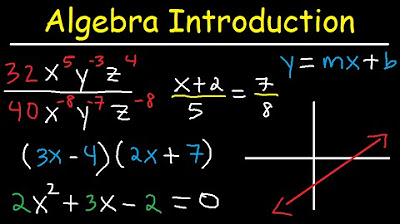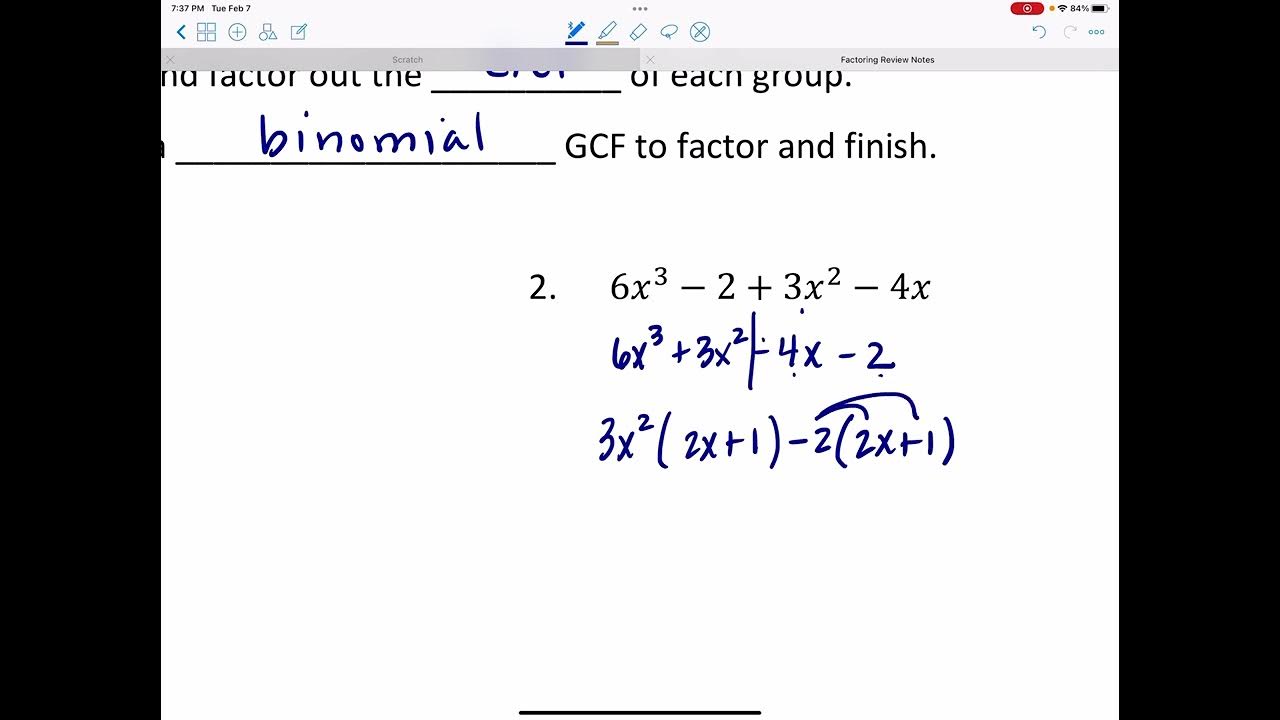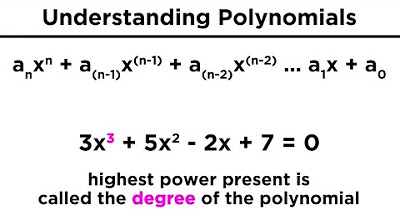Ch. 1.3 Algebraic Expressions
TLDRThis lecture delves into the fundamentals of algebraic expressions, focusing on polynomials. It explains the structure of polynomials, including terms, coefficients, and degrees, and distinguishes between monomials, binomials, and trinomials. The instructor emphasizes the importance of adding and subtracting like terms and the correct use of parentheses in polynomial subtraction. The lecture also covers multiplication techniques, special product formulas, and factoring methods, including the process of identifying and factoring out the greatest common factor (GCF). It provides examples to illustrate the concepts and stresses the relevance of strong algebraic skills for success in calculus.
Takeaways
- 📚 The lecture introduces algebraic expressions, focusing on polynomials, which are multi-term expressions with terms in descending order of power.
- 🔢 The script explains the structure of polynomials, including terms like leading coefficient (aₙ), constant term (a₀), and coefficients (aᵢ), where i is an integer.
- 📉 It clarifies that polynomials can be described by their degree or the number of terms, with specific names for polynomials with fewer than four terms: monomial, binomial, and trinomial.
- ✅ The importance of adding and subtracting like terms in polynomials is emphasized, noting that this is a common mistake among students.
- 👉 The script stresses the correct use of parentheses when subtracting polynomials to avoid errors in distributing negative signs.
- 📝 The process of multiplying polynomials is discussed, using the method of 'double distribution' across terms, which is fundamental for understanding algebraic properties.
- 📈 Special product formulas are highlighted for common multiplication scenarios, such as the difference of squares and the square of a binomial.
- 🔄 The relationship between factoring and multiplying polynomials as inverse operations is established, with factoring involving finding common factors and applying specific methods based on the number of terms.
- 🔍 The script details a step-by-step approach to factoring polynomials, including identifying the greatest common factor (GCF) and using methods like factor by grouping or Professor Choi's method for non-monic polynomials.
- 📚 The lecture provides examples of factoring polynomials, demonstrating the process of trial and error in finding correct factors and ensuring complete factorization.
- 💡 The transcript concludes with a complex example involving an algebraic expression with fractional exponents, where the GCF is pulled out to simplify the expression.
Q & A
What is an algebraic expression?
-An algebraic expression is a combination of variables, numbers, and operators (like addition, subtraction, multiplication, and division). It can include polynomials, exponentials, logarithms, and square roots.
What is a polynomial?
-A polynomial is an algebraic expression with multiple terms, each consisting of a variable raised to a power and multiplied by a coefficient. The terms are arranged in descending order of the powers.
What does 'poly' and 'nomial' mean in the context of a polynomial?
-'Poly' means many, and 'nomial' means terms. So, a polynomial refers to an expression with multiple terms.
What is the leading coefficient of a polynomial?
-The leading coefficient is the coefficient of the term with the highest power of the variable in the polynomial.
What is the constant term in a polynomial?
-The constant term is the term in the polynomial without a variable part, meaning it's just a real number and does not include any variables.
How can you describe a polynomial?
-A polynomial can be described by its degree, which tells you the highest power of the variable, or by the number of terms it contains, such as a monomial, binomial, trinomial, or simply a polynomial for four or more terms.
What is the importance of like terms when adding or subtracting polynomials?
-Like terms have the same variable part, and only these can be added or subtracted from one another. It's crucial to combine like terms correctly to simplify polynomials properly.
Why is it important to use parentheses when subtracting polynomials?
-Parentheses are important when subtracting polynomials to ensure that the negative sign is distributed correctly across all terms of the polynomial being subtracted, avoiding arithmetic errors.
What is the process of multiplying polynomials?
-Multiplying polynomials often involves the distribution property, also known as double distribution, where each term of one polynomial is multiplied by each term of the other polynomial. The result is then simplified by combining like terms.
What are special product formulas and why are they useful?
-Special product formulas are memorized results of common multiplication patterns, such as the difference of squares (a^2 - b^2) and perfect square trinomials (a^2 + 2ab + b^2). They simplify the process of multiplying expressions without having to use the full distribution method every time.
What is the relationship between factoring and multiplying polynomials?
-Factoring and multiplying polynomials are inverse operations. Factoring is the process of breaking down a polynomial into a product of simpler expressions, while multiplying is the process of combining those expressions.
What is the first step in factoring a polynomial?
-The first step in factoring a polynomial is to look for the greatest common factor (GCF) among all terms. Factoring out the GCF simplifies the expression and makes further factoring easier.
How can you factor a four-term polynomial?
-A four-term polynomial can be factored by grouping. This involves splitting the polynomial into two halves, factoring out the GCF from each half, and then looking for a common binomial factor that can be factored out from both groups.
What is a monic polynomial?
-A monic polynomial is a polynomial where the leading coefficient, the coefficient of the term with the highest power, is one.
How do you factor a monic trinomial?
-A monic trinomial can be factored by finding two numbers that multiply to give the constant term (last term) and add up to the middle term. These numbers become the coefficients of the two binomials in the factored form.
What is Professor Choi's method for factoring non-monic trinomials?
-Professor Choi's method involves factoring the leading coefficient and the constant term separately, then finding a combination of factors that, when multiplied together and combined with the variable part, will result in the original polynomial.
What does it mean if a polynomial is prime over the rational numbers?
-If a polynomial is prime over the rational numbers, it means that it cannot be factored any further using integer or rational coefficients.
What is the purpose of reviewing algebra in a pre-calculus course?
-The purpose of reviewing algebra in a pre-calculus course is to ensure that students have a strong foundation in algebra, as it is extensively used in calculus. Strong algebra skills make learning calculus concepts easier.
Why is it not advisable to expand expressions with fractional exponents?
-It is not advisable to expand expressions with fractional exponents because the exponent takes precedence according to the order of operations (PEMDAS). You must deal with the exponent before distributing any factors.
What is the greatest common factor (GCF) in the given complex algebraic expression with three terms?
-The GCF in the given expression includes the fractional part (one-third), the variable part (x raised to various powers), and the binomial term (2x - 1).
How can you simplify the given complex algebraic expression?
-You can simplify the expression by factoring out the GCF, which includes the common fractional exponent, the common variable part, and the common binomial term, and then simplifying the remaining terms.
Outlines
📚 Introduction to Algebraic Expressions and Polynomials
The script begins with an introduction to algebraic expressions, emphasizing the concept of polynomials as multi-term expressions that can include various mathematical operations like exponentials and logarithms. The lecturer advises students to take notes and provides a basic definition of polynomials, breaking down terms such as 'poly' meaning many and 'nomial' meaning numbers. The structure of polynomials is described, highlighting the descending order of terms from the highest power to the constant term, which is independent of any variable. The leading coefficient and constant term are defined, and the importance of understanding polynomials is underscored in preparation for more in-depth analysis in later chapters.
🔍 Understanding Polynomial Terms and Operations
This paragraph delves deeper into the structure of polynomials, explaining the concept of terms and coefficients within polynomial expressions. It clarifies that each 'a_sub_i' represents a coefficient, and 'n' denotes the degree of the polynomial. The paragraph discusses how polynomials can be described by their degree or the number of terms they contain, introducing terms like monomial, binomial, and trinomial based on the number of terms present. The importance of adding and subtracting like terms is emphasized, and a common mistake made by students when subtracting polynomials without properly distributing negative signs is pointed out. The section concludes with an introduction to multiplying polynomials using the distribution property, also known as 'double distribution,' which is a fundamental algebraic skill.
📘 Multiplication of Polynomials and Special Product Formulas
The script continues with a detailed explanation of how to multiply polynomials using the distribution method, emphasizing the importance of directionality in the multiplication process. It illustrates the process with an example, showing how to expand and simplify polynomials by combining like terms. The paragraph then introduces special product formulas, such as the difference of squares and the formula for squaring a binomial, which are essential for simplifying complex expressions. These formulas are highlighted as common results in algebra that students should memorize to facilitate easier problem-solving.
📙 Factoring Polynomials and the Process of Unraveling Expressions
The fourth paragraph introduces the concept of factoring polynomials as the inverse operation to multiplying them. It discusses the relationship between factoring and multiplying, comparing it to the inverse relationship between addition and subtraction, as well as multiplication and division. The paragraph outlines the process of factoring, starting with identifying the greatest common factor (GCF) and considering the number of terms in the polynomial to determine the factoring method. It mentions the hierarchy of factoring steps, including factoring by grouping for four terms and different strategies for three-term polynomials, depending on whether the leading coefficient is one or not. The paragraph concludes with a reminder to ensure that the factoring process is complete and no further factoring is possible.
📓 Factoring Techniques and Professor Choi's Method
This paragraph expands on the factoring techniques mentioned earlier, focusing on Professor Choi's method for factoring trinomials, particularly when the leading coefficient is not one. The method involves factoring out the leading coefficient and then using a trial-and-error approach to find the correct factors of the constant term that add up to the middle term. The paragraph provides a step-by-step guide on how to apply this method, including how to adjust the signs of the factors to achieve the correct middle term. It also emphasizes the importance of using intuition and number sense to quickly identify the correct factors.
📒 Factoring Examples and the Importance of Algebra in Calculus
The script presents examples of factoring polynomials, starting with a four-term polynomial where a GCF is pulled out, followed by factoring by grouping. It then moves on to a monic trinomial, which is factored by finding factors of the constant term that add up to the middle term. The paragraph also addresses a non-monic trinomial, using Professor Choi's method to find the correct factors. The importance of strong algebra skills for success in calculus is highlighted, as calculus builds upon algebraic foundations. The lecturer encourages students to view the review of algebra through the lens of precalculus to prepare for the challenges of calculus.
📕 Complex Algebraic Expressions and Factoring with Common Terms
The final paragraph introduces a complex algebraic expression with fractional exponents, which is not a polynomial due to its non-integer powers. The script explains that this expression cannot be simplified by expansion due to the presence of exponents that must be dealt with first. Instead, the focus is on identifying and factoring out the greatest common factor (GCF) from the expression. The paragraph demonstrates how to factor out one-third, x to the one-half, and the binomial term (2x - 1), transforming the original expression into a more manageable form. The lecturer suggests that while further factoring may be possible, the expression has been simplified to a reasonable degree by extracting the GCF.
Mindmap
Keywords
💡Algebraic Expressions
💡Polynomials
💡Coefficients
💡Terms
💡Indices
💡Degree of the Polynomial
💡Like Terms
💡Distributive Property
💡Special Product Formulas
💡Factoring
💡Greatest Common Factor (GCF)
💡Monic Polynomial
💡Professor Choi's Method
Highlights
Introduction to algebraic expressions, focusing on polynomials and their components.
Explanation of the term 'polynomial', breaking it down to its meaning of 'many terms'.
Importance of keeping notes while watching lecture series for better understanding.
Description of polynomial structure with descending powers of variables.
Clarification on the concept of coefficients and terms within a polynomial.
Differentiation between monomial, binomial, trinomial, and general polynomials based on the number of terms.
Emphasis on the necessity of adding and subtracting like terms in polynomial arithmetic.
Guidance on using parentheses correctly when subtracting polynomials to avoid arithmetic errors.
Introduction of the 'double distribution' method for multiplying polynomials.
Explanation of special product formulas for common algebraic patterns.
Discussion on factoring polynomials as the inverse operation to multiplication.
Technique of factoring by grouping for four-term polynomials.
Use of Professor Choi's method for factoring non-monic trinomials.
Process of ensuring complete factoring of polynomials and identifying when factoring is finished.
Example of factoring a four-term polynomial with a GCF and binomial GCF.
Example of factoring a monic trinomial using the constant term's factors.
Application of Professor Choi's method to factor a non-monic trinomial with trial and error.
Complex example involving an algebraic expression with fractional exponents and common factors.
Final thoughts on the importance of strong algebraic skills for an easier transition into calculus.
Transcripts
Browse More Related Video
5.0 / 5 (0 votes)
Thanks for rating:





